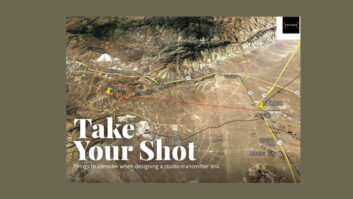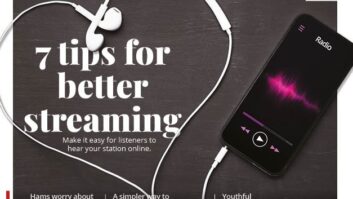COLORADO SPRINGS, Colo. Focus on the Family is not what one expects when one thinks of a typical radio station.
We are a Christian organization founded in 1977 by Dr. James Dobson, devoted to promoting families and family life as defined by the Christian faith. To fulfil a target like this and offer interested audiences a broad spectrum of information, we publish a variety of magazines, videos, and audio recordings.
Additionally we do a daily broadcast, which is sent to our FTP site where stations can download files or stream live feeds at anytime.
Our focus has been, and continues to be, on producing audio and video content, mainly recorded, or syndicated, which then is fed out by FTP, Web streaming, podcasts or even video uplinks.
Today, FOTF reaches 220 million listeners in 160 countries on more than 7,000 stations.
Modernization
Naturally under conditions like these, our studios need to be quite different from those of a standard radio station.

The author in the FNIF1 studio at the Focus on the Family studio complex. When we started to switch from obsolete analog studio technology to digital several years ago, we were looking for a partner who on the one hand could streamline our workflow processes and on the other hand map our workflow processes into the new broadcast and production system.
Step by step we started to convert one studio after another from our older analog mixing desks to VADIS D.C.II consoles from Klotz Digital. Our research indicated that the VADIS D.C. II line had a reputation for quality, flexibility, great sound and astonishing network abilities.
We also wanted to get rid of external control boxes, which usually were added to our past mixer boards that were inadequate to handle the functions we needed. We soon learned that the Klotz Digital system can do just about anything you put your mind to.
The networking abilities are a crucial factor as we have 10 full studios in the FOTF Colorado Springs facility. Today all of them are networked via our central equipment area, called Audio Machine Room 1 (AM1), which is equipped with two VADIS audio and control engines.
In the meantime four of our 10 full studios, A, D, E and FNIF 1, which is used for production of “Family News in Focus,” have VADIS D.C.II consoles. Our daily broadcast is recorded in Studio A. The studio itself has an elaborate set suitable for television, so that when television broadcasts are done there is little or no need for special setup. The set is lit for television, is soundproofed and features a visitors’ gallery that seats around 80–100 people and looks directly into the studio itself. There are microphones in the gallery so that Dr. Dobson or one of his guests can take questions and comments from the gallery audience.
The control room adjoins the studio and has a large window offering sight lines to the entire studio and the visitors’ gallery. The control room is equipped with a 24-fader VADIS D.C.II mixing console and two VADIS D.C.II console panels used for monitoring, control of various speakers, such as those in the gallery and outer gallery speaker area, for control of signal lights, intercom, as well as IFB talkback to callers and talent via ISDN or other remote equipment.
Different modes
FOTF Studio A was the first implementation of what Klotz Digital calls the “Offline Chat” mode, a feature that was more than welcome and is used often.
This mode mixes selected microphones and remote equipment, pre-fader into a “chat” mix, which is then fed to the talent, producer and screener headsets during breaks while commercials and other audio clips are going out live on the board.
By pushing one button the entire crew and talent of the broadcast can talk to each other while their mics are off, without having to remove their headphones and move about or shout to be heard. Effectively, during breaks, it “dissolves” the glass between control room and studio and allows unobstructed communication between contributors whether in any of the studios or by remote equipment.
Although the equipment differs marginally, Studio D and E functionally are identical. The VADIS D.C.II console system has a 12-fader control surface and control room D is additionally equipped with a four-fader mini-console for the producer.
All of our studios have guest positions. Studio A has six, Studio D has four, while Studio E and FNIF have three. All of these positions have talent panels that facilitate on/off/cough control of their respective microphones. Another advantage of the Klotz Digital system: the producer or console operator can talk back to any one guest headset or to all of them.
The central technical area, AM1, carries shared resources used by all studios and makes the resources of one studio available to all others. AM1, as well as each studio, has “Mode” buttons, so that when pressed, predetermined routes and feeds are routed and then everything is returned to a “normal” state when pressed a second time.
Furthermore AM1 allows ISDN codecs and telephone hybrids to be shared among studios. Even the studios that are not equipped with consoles from Klotz Digital — Studios B and C, for example, which still have older analog consoles — have feeds to and from AM1. Those are controlled via Radio Systems controllers that communicate to VADIS via RS-422.
In addition, we have a dubbing bay, satellite operations and two Foley rooms, which are all connected to AM1. The Foley rooms have mic lines to the control rooms and are provided with Foley pits with common surfaces, like concrete, gravel, stairs, linoleum, hardwood, carpet, sand, turf, etc.
With our studio upgrades, we thought we’d put our product supplier through its paces. Far from it! We were positively surprised by the expertise of Klotz Digital’s engineering team and the technical sophistication of the VADIS product range.
I am also pleased with the ability to change virtually anything, keeping the board operation up to date and relevant with the equipment we have at that time and what we are doing at that point in time.
We are very satisfied with the results that ushered us successfully into the new, digital era and look forward to upgrading our FNIF 2 studio as well.
Richard Reich is a senior broadcast engineer with Focus on the Family.
For information, contact Klotz Digital at (678) 966-9900 or visitwww.klotzdigital.com.












